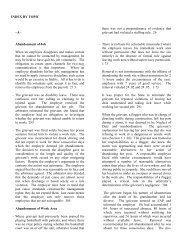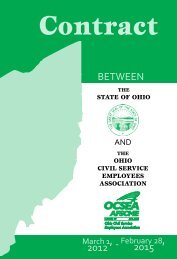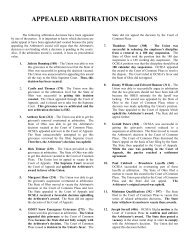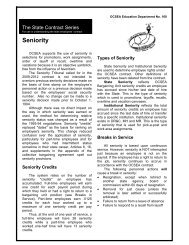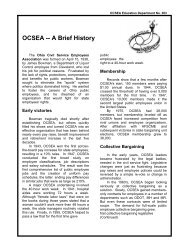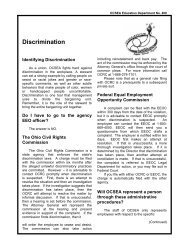by Contract Number (PDF) - OCSEA
by Contract Number (PDF) - OCSEA
by Contract Number (PDF) - OCSEA
Create successful ePaper yourself
Turn your PDF publications into a flip-book with our unique Google optimized e-Paper software.
won is not sufficient to prove increased<br />
efficiency and economy as required.” Not having<br />
to pay the grievant’s salaries is insufficient<br />
evidence of the employer’s increased economy<br />
and efficiency. 311<br />
The Union grieved the fact that displaced<br />
supervisors bumped into the bargaining unit. The<br />
arbitrator analyzed the bumping rights of<br />
displaced supervisors <strong>by</strong> narrowing the issue into<br />
one pivotal question: Whether or not the Union<br />
obtained contractual language restricting<br />
bumping to covered employees. If the<br />
Agreement is silent or the State negotiators<br />
preserved Civil Service bumping rights for<br />
displaced supervisors, the grievance will be<br />
denied. 336<br />
A grievance dealing with job abolishment and<br />
layoffs is arbitrable. The jurisdiction of an<br />
arbitrator extends only to these matter which the<br />
parties <strong>by</strong> their Agreement empower the<br />
arbitrator. Article 5 is not without limitations,<br />
“Such rights shall be exercised in a manner<br />
which is not inconsistent with this Agreement.”<br />
Section 25.01 enables an arbitrator to decide any<br />
difference, complaint or dispute affecting terms<br />
and/or conditions of employment regarding the<br />
application, meaning or interpretation of the<br />
Agreement. The procedural and/or substantive<br />
underpinnings of an abolishment decision<br />
dramatically impact employee’s terms and<br />
conditions of employment. A limitation on the<br />
powers of an arbitrator need to be clearly and<br />
unequivocally articulated; a reserved rights<br />
clause does not serve as an adequate bar. 340<br />
Section 43.02 which deals with the preservation<br />
of employee benefits also points towards<br />
abolishment decisions being reviewable <strong>by</strong> an<br />
arbitrator. The benefits are not limited to<br />
economic gains. An appeal from an abolishment<br />
of layoff decision is a form of benefit and arbitral<br />
review is preserved. 340<br />
When the Agreement is silent on who has the<br />
burden of proof and the standard of proof,<br />
Section 43.02 prevails and the relevant<br />
regulations and statutory law apply. In this case<br />
that means that the employer has the burden of<br />
proving <strong>by</strong> a preponderance of the evidence that<br />
the job abolishments were properly<br />
implemented. 340<br />
When the appointing authority decides to<br />
implement an abolishment they must file a<br />
statement of rationale with the Department of<br />
Administrative Services. This rationale must<br />
only specify the reason for the abolishment:<br />
reorganization for efficient operation, reasons of<br />
economy, or lack of work. No further<br />
documentation is required. At this stage of the<br />
abolishment process statistical data and<br />
additional supporting material are unnecessary.<br />
340<br />
The arbitrator found that he was not bound <strong>by</strong><br />
the reasons given in the abolishment rationale in<br />
deciding the propriety of the abolishments. 340<br />
The arbitrator found that post abolishment data is<br />
not only allowed into evidence, it may help the<br />
employer meet its burden <strong>by</strong> comparing current<br />
work levels versus work levels where the wok<br />
did not exist. Both the Bispeck and Esselburne<br />
decisions underscore the need to address<br />
comparative data rather than the steady-state<br />
analysis proposed <strong>by</strong> the employer. 340<br />
A job abolishment contemplates the permanent<br />
deletion of a position. It does not mean laying off<br />
one person while leaving the position intact for<br />
another person to fill. [same work previously<br />
performed <strong>by</strong> the ousted employee is presently<br />
performed, as a function of a mere transfer, <strong>by</strong><br />
others in a similar capacity.] Nothing in the<br />
abolishment statutes however prohibits an<br />
appointing authority from consolidating or<br />
redistributing some of the employee’s duties to<br />
other employees. Consolidation takes place when<br />
job elements are assigned to others within the<br />
organization but the consolidated job elements<br />
do not represent a substantial percentage of the<br />
“new” position. A valid redistribution takes<br />
place when various aspects of the abolished<br />
position are distributed amongst existing<br />
positions. 340<br />
A mere job transfer does not equal a job<br />
abolishment; the position was not permanently<br />
eliminated. The employer also violated Section<br />
1.03 of the Agreement <strong>by</strong> having a supervisor<br />
take over bargaining unit work. 340<br />
The employer abolishing a position and having<br />
the same employee become a part-time<br />
employee doing the same work as she did<br />
previously on a full-time basis points toward the<br />
abolishment being improper. The original<br />
position was still intact, the grievant instead of<br />
working forty hors a week worked thirty nine.




